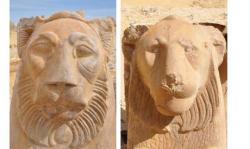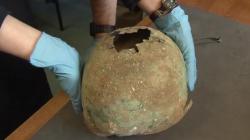INSTITUT SUPERIEUR D'ANTHROPOLOGIE
INSTITUTE OF ANTHROPOLOGY
ONLINE COURSES / COURS A DISTANCE
NEW OPEN COURSE : JANUARY 2013
HRM 104 : INTRODUCTION TO INTANGIBLE CULTURAL HERITAGE
REGISTER NOW
EGYPTE – 
 Dimeh Al-Siba - The Italian archaeological mission of Salento-Litchi University stumbled upon a pair of gigantic seated lion statues on Monday. They were found erected at the entrance of Soknopaios Temple at the Ptolemaic town, Dimeh Al-Siba, in Fayoum. Dimeh Al-Siba, which means ‘Island of the Crocodile god,’ is located eleven kilometres to the north of Qarun Lake. It was founded by Ptolemy II on top of a Neolithic residential area. The Ptolemaic-era town contains a collection of residential houses, a large temple to worship Sknopaios, in ancient Egypt Sobek-en-Pai (crocodile), a bakery and a market. During excavation work carried out by archaeologist and director of the Italian mission, Mario Capasso, a pair of lion statues appeared on the sand surface. The lion statues are skillfully carved of limestone and were presumably used to decorate the entrance gate of the temple. Mohamed Ibrahim, Antiquities Minister, describes the discovery as interesting, as it confirm that the temple was constructed according to an architectural plan used in main temples in large cities and capital. “It is also the first time that the gigantic lion shaped statues can be unearthed in a small Greco-Roman settlement in Fayoum,” said Ibrahim. Both statues are in a very well-preserved condition and are now at the Fayoum storehouse for restoration.
Dimeh Al-Siba - The Italian archaeological mission of Salento-Litchi University stumbled upon a pair of gigantic seated lion statues on Monday. They were found erected at the entrance of Soknopaios Temple at the Ptolemaic town, Dimeh Al-Siba, in Fayoum. Dimeh Al-Siba, which means ‘Island of the Crocodile god,’ is located eleven kilometres to the north of Qarun Lake. It was founded by Ptolemy II on top of a Neolithic residential area. The Ptolemaic-era town contains a collection of residential houses, a large temple to worship Sknopaios, in ancient Egypt Sobek-en-Pai (crocodile), a bakery and a market. During excavation work carried out by archaeologist and director of the Italian mission, Mario Capasso, a pair of lion statues appeared on the sand surface. The lion statues are skillfully carved of limestone and were presumably used to decorate the entrance gate of the temple. Mohamed Ibrahim, Antiquities Minister, describes the discovery as interesting, as it confirm that the temple was constructed according to an architectural plan used in main temples in large cities and capital. “It is also the first time that the gigantic lion shaped statues can be unearthed in a small Greco-Roman settlement in Fayoum,” said Ibrahim. Both statues are in a very well-preserved condition and are now at the Fayoum storehouse for restoration.
http://english.ahram.org.eg/NewsContent/9/41/59724/Heritage/GrecoRoman/Lionshaped-statues-unearthed-in-Fayoum.aspx
MONGOLIE –  Khentii - "Il est indéniable que Gengis Khan a changé le cours de l'histoire. Pourtant nous connaissons peu de choses sur cette figure historique" affirme Albert Lin, explorateur et chercheur de National Geographic dans un entretien exclusif dans Newsweek Magazine paru ce mardi. Un projet de recherche multidisciplinaire en cours, réunissant des scientifiques américains et des chercheurs et archéologues mongols pourrait révéler qu'il se passe des choses sur la chaîne de montagnes Khentii en Mongolie. Parmi les découvertes de l'équipe, il y a les fondements de ce qui semble être un monument du 13ème ou 14ème siècle, dans une région qui a toujours été associée à la présence de ce lieu de sépulture. Les scientifiques ont trouvé un large éventail d'objets : pointes de flèches, porcelaine, variété de matériaux de construction. Selon l'explorateur tout serait cohérent. Si les résultats le confirment, cette découverte archéologique sera l'une des plus importantes depuis des années. Des milliers de personnes ont été sollicitées pour passer au crible les données satellites et photographiques. Dans un laboratoire de l'Institut californien de technologie, télécommunication et information de l'Université de San Diego, Lin et son équipe passent au peigne fin le volume d'images satellites à très haute résolution et reconstituent des paysage en 3-D. Dans le cadre d'un projet open-source sans précédent, des milliers de volontaires ont partagé 85 000 images satellitaires à haute résolution afin que l'équipe puisse identifier les détails de structures occultées. Depuis sa mort il y a 800 ans, le lieu du dernier repos du chef militaire mongol Gengis Khan fait l'objet de recherches. Tout a été fait, au moment de sa perte, pour cacher la tombe afin de la protéger d'éventuels pilleurs. La légende raconte que l'escorte funèbre de Khan tuait quiconque croisait son chemin pour ne laisser aucun indice du lieu de repos du grand chef. Ceux qui ont construit le tombeau funéraire ont été tués, idem pour les soldats qui les ont achevés. L'emplacement de cette tombe est l'un des mystères les plus durables de l'archéologie.
Khentii - "Il est indéniable que Gengis Khan a changé le cours de l'histoire. Pourtant nous connaissons peu de choses sur cette figure historique" affirme Albert Lin, explorateur et chercheur de National Geographic dans un entretien exclusif dans Newsweek Magazine paru ce mardi. Un projet de recherche multidisciplinaire en cours, réunissant des scientifiques américains et des chercheurs et archéologues mongols pourrait révéler qu'il se passe des choses sur la chaîne de montagnes Khentii en Mongolie. Parmi les découvertes de l'équipe, il y a les fondements de ce qui semble être un monument du 13ème ou 14ème siècle, dans une région qui a toujours été associée à la présence de ce lieu de sépulture. Les scientifiques ont trouvé un large éventail d'objets : pointes de flèches, porcelaine, variété de matériaux de construction. Selon l'explorateur tout serait cohérent. Si les résultats le confirment, cette découverte archéologique sera l'une des plus importantes depuis des années. Des milliers de personnes ont été sollicitées pour passer au crible les données satellites et photographiques. Dans un laboratoire de l'Institut californien de technologie, télécommunication et information de l'Université de San Diego, Lin et son équipe passent au peigne fin le volume d'images satellites à très haute résolution et reconstituent des paysage en 3-D. Dans le cadre d'un projet open-source sans précédent, des milliers de volontaires ont partagé 85 000 images satellitaires à haute résolution afin que l'équipe puisse identifier les détails de structures occultées. Depuis sa mort il y a 800 ans, le lieu du dernier repos du chef militaire mongol Gengis Khan fait l'objet de recherches. Tout a été fait, au moment de sa perte, pour cacher la tombe afin de la protéger d'éventuels pilleurs. La légende raconte que l'escorte funèbre de Khan tuait quiconque croisait son chemin pour ne laisser aucun indice du lieu de repos du grand chef. Ceux qui ont construit le tombeau funéraire ont été tués, idem pour les soldats qui les ont achevés. L'emplacement de cette tombe est l'un des mystères les plus durables de l'archéologie.
http://www.atlantico.fr/decryptage/et-on-avait-decouvert-tombe-gengis-khan-566103.html
COREE DU SUD - Jindo Island - Here off the southern coast of Korea near Jindo Island, Korean archaeologists have made a significant find, one that provides a glimpse of Korea's rich cultural history. Rare artifacts were uncovered deep on the ocean floor, perfectly preserved for centuries. The National Research Institute of Maritime Cultural Heritage recently revealed their finds to the public, with 16th-century Korean guns as the showcased centerpiece. [Interview : Im Gyeong-hee, Curator Cultural Heritage Administration] "This is the first discovered firearm identified as Sososeungja Chongtong . The craftsman's name and date of production are all perfectly preserved, and this has high historical significance." Over 70 fragments of pale blue-green ceramics were also found in the underwater wreckage. Estimates date them back to the late 12th century and early 13th century during the Goryeo Dynasty. The animal-shaped incense burners are of such high quality that they are believed to have been used by the royal family or nobles. [Interview : Sung Nak-jun, Director National Research Institute of Maritime Cultural Heritage] "When compared to current national treasures and relics, these excellent pieces of Goryeo celadon are just as good. It's assumed that they were lost along the waters of Oryu while they were being transported from Gangjin." The institute says they've merely scratched the surface with the preliminary survey. They plan to begin a full survey of the area next year in order to reach deeper into Korea's past.
http://www.arirang.co.kr/News/News_View.asp?nseq=141265&code=Ne6&category=7
ROYAUME UNI – Marlow - The Heritage Lottery Fund has awarded a grant of £9,800 to Marlow Archaeology to further investigate a public park in Marlow where they may have uncovered evidence of a 16th century chapel. During their digs around March, time detectives found a chalk block wall at the site which may date back to the 1500s. The organisation said some have speculated that this may have connection with a medieval chapel associated with a Knights Hospitallers 'Hospital' - thought to have been situated somewhere in the vicinity.
http://www.bucksfreepress.co.uk/news/10085837.Lottery_win_for_archaeologists/
AFRIQUE DU NORD - Certaines populations actuelles d'Afrique du Nord, notamment des Berbères de Tunisie et des Sahraouis, ont un peu de génome néandertalien dans leur ADN, selon une étude internationale. Cette particularité a aussi été mise en évidence en 2010 pour les Européens et Asiatiques actuels. Toutes ces populations descendent donc probablement d'un même groupe d'ancêtres, qui s'est métissé avec des néandertaliens il y a 80 000 à 40 000 ans. Ensuite, entre 40 000 et 20 000 ans, une partie de ce groupe serait arrivée en Afrique du Nord, pour donner naissance aux populations berbères et sahariennes.
http://www.larecherche.fr/actualite/archeologie/neandertal-berbere-01-12-2012-95284
ROYAUME UNI –  Canterbury – A rare Iron Age helmet unearthed by a metal detector enthusiast on farmland near Canterbury has been described as a significant find by the British Museum. The bronze helmet was found with bone fragments, and had been used to hold human remains after a cremation, Canterbury Archaeological Trust said. University of Kent experts have found it dates back to the 1st Century BC. A brooch that would have fastened a bag holding the cremated bone was also unearthed. Julia Farley, Iron Age curator at the British Museum, said it was one of a handful of Iron Age helmets found in Britain. She said it was not unusual to bury cremated remains in a bag fastened with a brooch in late Iron Age Kent. But she said: "No other cremation has ever been found accompanied by a helmet."
Canterbury – A rare Iron Age helmet unearthed by a metal detector enthusiast on farmland near Canterbury has been described as a significant find by the British Museum. The bronze helmet was found with bone fragments, and had been used to hold human remains after a cremation, Canterbury Archaeological Trust said. University of Kent experts have found it dates back to the 1st Century BC. A brooch that would have fastened a bag holding the cremated bone was also unearthed. Julia Farley, Iron Age curator at the British Museum, said it was one of a handful of Iron Age helmets found in Britain. She said it was not unusual to bury cremated remains in a bag fastened with a brooch in late Iron Age Kent. But she said: "No other cremation has ever been found accompanied by a helmet."
http://www.bbc.co.uk/news/uk-england-kent-20594096